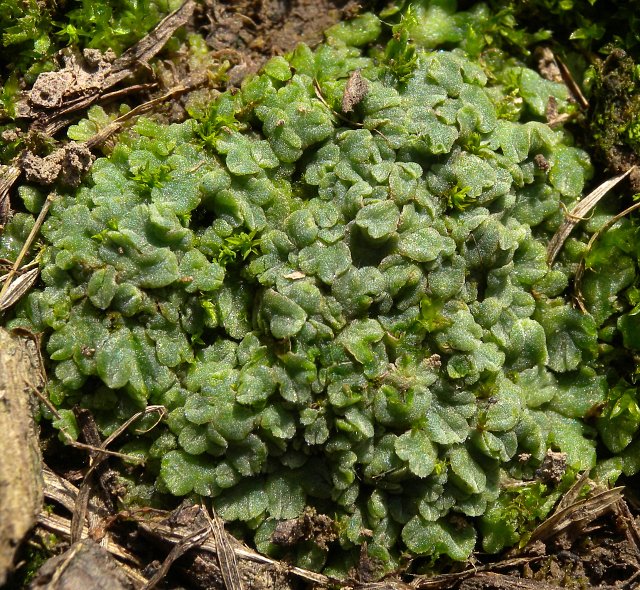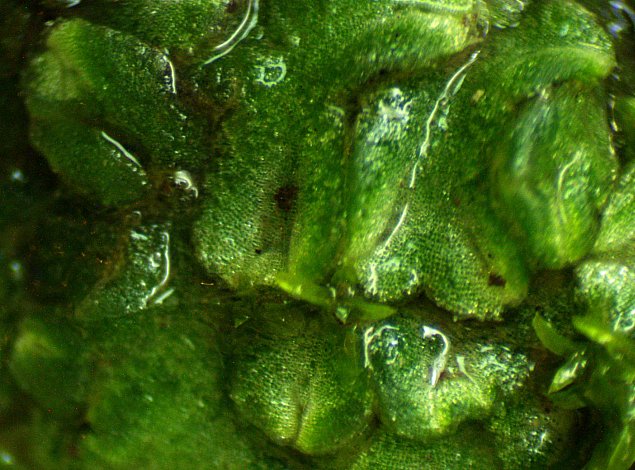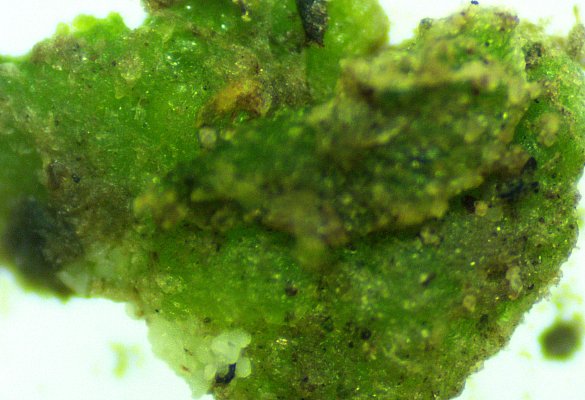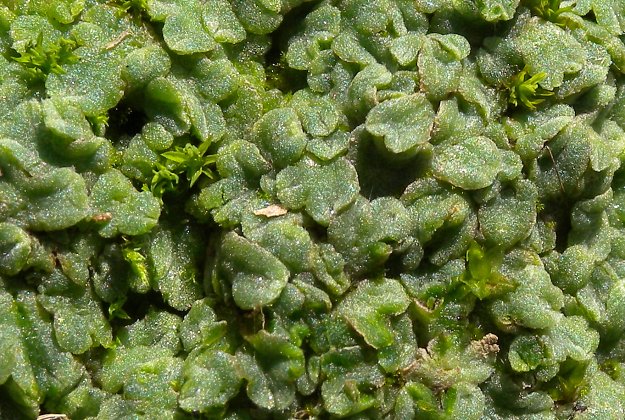
The upper surface of the thallus has very fine and shallow indentations from a fine network of single-pored cells. These angular-rounded cells are green toward their centers and whitish toward their margins, providing the upper thallus surface with the appearance of lizard skin. The bottom of the thallus is flat and largely light green. Sometimes there are short white hairs at the bottom of the notched tips of the thallus lobes, but they are very few in number and quite inconspicuous. This liverwort is monoecious, producing antheridia (male sexual organs) and archegonia (female sexual organs) on the same plant. These sexual organs are located near, or at, the upper surface of the thallus and they are quite inconspicuous. After the sperm of the antheridia fertilize the eggs of the archegonia of the same or neighboring plants, the archegonia develop spore cases that become mature during late autumn or early winter. These spore cases are revealed as inconspicuous bumps on the upper surface of the thallus, where they remain embedded. The spores are not released to the outside world until the surrounding thallus containing them deteriorates. The spores are 70-110 micrometers across, globoid in shape, and reticulated-warty. These spores are small enough that they can be blown about by the wind or transported by water.

Cultivation: The preference is full sun, moist to dry conditions, and a substrate containing clay, loam, mud, sand, or gravelly material. While this liverwort can adapt to surprisingly dry sites, it usually occupies microhabitats that are more moist from depressions in the ground surface, or that are more moist from the presence of nearby rocks or pavement. This non-vascular plant is intolerant of competition from larger vascular plants. It has been successfully cultivated in greenhouses.
Range & Habitat: Lizard Crystalwort (Riccia bifurca) is native to Illinois, where it is apparently rare (see Distribution Map). This liverwort was collected in Woodford County in 1937, and it was observed in Vermilion County by the webmaster in 2016. Because this liverwort is small and inconspicuous, and achieves its largest size only during the autumn, it is probably more common within the state than these records indicate. Lizard Crystalwort is widely distributed in North America, Europe, Australia, and other parts of the world. In Illinois and neighboring areas, habitats for this plant include sandy banks along rivers, exposed rocky outcrops, stubble fields, areas near parking lots, exposed ground along roadside ditches, and barren waste areas. This plant is a pioneer ephemeral species that usually colonizes open disturbed areas, although it also occurs in barren natural areas.

Faunal Associations: Little is known about floral-faunal relationships for this little plant. It is possible that vertebrate animals and some invertebrate animals (e.g., earthworms) may play an important role in spreading the spores to new locations. For example, the tiny spores can probably cling to the muddy feet of vertebrate animals and the shoes of humans. They may also cling to the sticky bodies of earthworms or pass through their gullets while remaining viable.
Photographic Location: Near a parking lot and picnic area at Kickapoo State Park in Vermilion County, Illinois.

Comments: The non-vascular plants, liverworts, are usually found in either wetlands or damp shaded woodlands. Lizard Crystalwort (Riccia bifurca) and several other Crystalwort species (Riccia spp.) are unusual in their ability to colonize surprisingly dry and sunny sites. Distinguishing among Crystalwort species is rather difficult as they superficially appear rather similar to each other. All of these species are small in size (usually less than 1" across) and relatively flat, consisting of dichotomously branched thalli. Lizard Crystalwort can be distinguished from several similar species using the following set of criteria: 1) the upper surface of its thallus lacks conspicuous cavities, unlike Riccia cavernosa and Riccia sullivantii, 2) the lower margins of its thallus lobes lack significant hairs, unlike Riccia beyrichiana and Riccia hirta, 3) the grooves along the upper surface of its thallus lobes are usually quite wide, except at the tips of its lobes, while Riccia sorocarpa and Riccia hirta have narrow grooves throughout, and 5) its thallus lobes are tongue-shaped, rather spoon-shaped like Riccia frostii. Other characteristics to be considered are the shape of thallus margin (flattened, swollen, or wall-like), size and appearance of the spores, and overall size of the thallus lobes. These are fascinating little plants that are worthy of further study. Unfortunately very few people pay any attention to them. An obsolete scientific name of Lizard Crystalwort is Riccia arvensis.